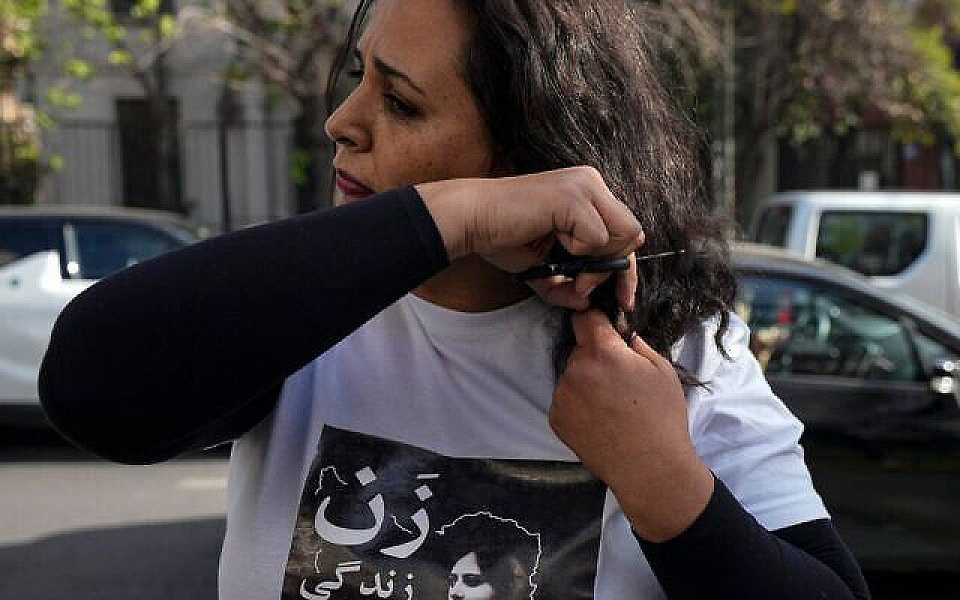Thousands of Iranians have taken to the streets in protest following the death of Mahsa Amini. A 22-year-old girl from Saqez was visiting Tehran on 13 September. She was arrested, brutally beaten and murdered by Iran’s so-called “Morality Police” for not wearing her hijab in accordance with government standards.
Mahsa Amini was hospitalized after the arrest where she died after 3 days. According to the hospital she was already brain-dead when admitted to the clinic. Iranian government tried forging medical records, stating that Amini had a history of pre-existing medical conditions that led to this fatal incident. However, her family has denied the government’s claims and accused authorities of lying.
Mahsa Amini’s death sparked widespread anger locally and internationally. Since the tragedy, protests have taken place in at least 40 cities of Iran, including the capital city Tehran. Demonstrators demand ending violence and oppression against women and as well as cancelling compulsory wearing of the hijab. As a sign of protests, Iranian women can be seen taking off their hijab publicly and burning them, dancing in the streets, cutting locks of their hair and chanting: “Death to the dictator” - a reference to the Supreme Leader, Ayatollah Ali Khamenei.
As the protests have grown, Iran decided to cut off internet access in the parts of Tehran and Kurdistan and blocked access to platforms like Instagram and WhatsApp, two of the most popular social media services in the country. The Iranian government hopes to hinder the mobilization of protests: social media served an important platform which provided information on when and where protests took place. The hashtag #MahsaAmini became one of the most repeated hashtags on Twitter and Instagram. The decision of Iran can be understood as an extension of the repression against Iranian citizens. Spreading videos around the internet of women burning off their hijabs and cutting their hair was inspiring more people to stand in solidarity with demonstrators, and videos showing the police brutality were motivating people to unite and take action against the current regime. It is a well-known fact that social media impacts the development of protest movements in different ways. It can importantly contribute to the growth of the protest movement, as well as it can encourage the participation of new members and can make it easy to spread and acquire information. Notably, people have reported that text messages that contain Mahsa Amini’s name are blocked.
Shutting off the internet is well familiar tool of Iranian authorities to suppress the protests. In 2019, by the Order of Supreme National Security Council the most wide-scale internet shutdown ever happened In Iran. After the gas prices were increased in the country, demonstrators joined mass protests in Tehran and other cities. Just like now, in 2019, by shutting down the internet the Iranian government was trying to prevent the spread of videos and images showing police violence against protesters. The Iranian regime murdered estimated number of 1500 people and injured 4800 people protesting the rises in gas prices, making the month of November 2019 to be known as ‘bloody November’. So far, the internet shutdowns following Amini’s death haven’t reached the same scale. However, it is still early to predict.
The Islamic Revolution in 1979, brought harsh repression against Iranian women. Since the revolution, Sharia laws in Iran require women to wear hijabs and loose clothes in public. Ayatollah Ruhollah Khomeini, leader of the revolution considered women’s equality incompatible with the strict Islamic society he sought to create. In 1980, Ayatollah Khomeini fired all female judges. By 1981, women were not allowed to show their arms in public and time after time, restrictions just kept growing.
Despite the internet shutdown, footages from protests have managed to get out. Security forces have been attacking protesters with tear gas and live ammunition, so far, reportedly 1200 people have been detained and 71 killed in the clashes with authorities.
Iran’s president Ebrahim Raisi condemned the women-led protests in Iran and called demonstrations chaos. He warned: “Whoever participated and ignited the chaos and riots will be held to account." Raisi also blamed outside forces for unrest, including “counter-revolutionary” Kurdish groups based in northern Iraq. So did Iranian Foreign Minister Hossein Amir-Abdollahian, who accused outside sources for inciting violence in Iran.
Iran’s response has drawn concern from all around the world. Solidarity protests were held worldwide. The Iranian Ambassadors were summoned by Germany and Spain, and new sanctions were announced by the US and Canada. The United States condemned the brutal death of Mahsa Amini and in response to this and violent suppression of peaceful protests, on September 22, the US announced imposing sanctions on Iran’s Morality Police and senior security officials who have engaged in serious human rights abuses. On September 26, Canada also imposed sanctions again Iran’s Morality Police and its leaders. "Today, I'm announcing that we will implement sanctions on dozens of individuals and entities, including Iran's so called morality police," President Justin Trudeau said. Moreover, the United Nations closely follows the protests in Iran: “We call on the authorities to respect women’s rights and to eliminate all forms of discrimination against women and girls and implement effective measures to protect them from other human rights violations, in accordance with international standards.”
The death of Mahsa Amini has ignited the flame and women are not backing down. Large number of men are protesting alongside Iranian women. They are fighting bravely against decades of oppression and pay the bitter price with their tears and blood. So far, the Iranian authorities have failed at silencing the demonstrations despite their brutal attempts. We are witnessing history; the current protests are unparalleled in its scale: Iranian women fighting against patriarchy manifested in its most violent form.
Photo by Esteban Felix

